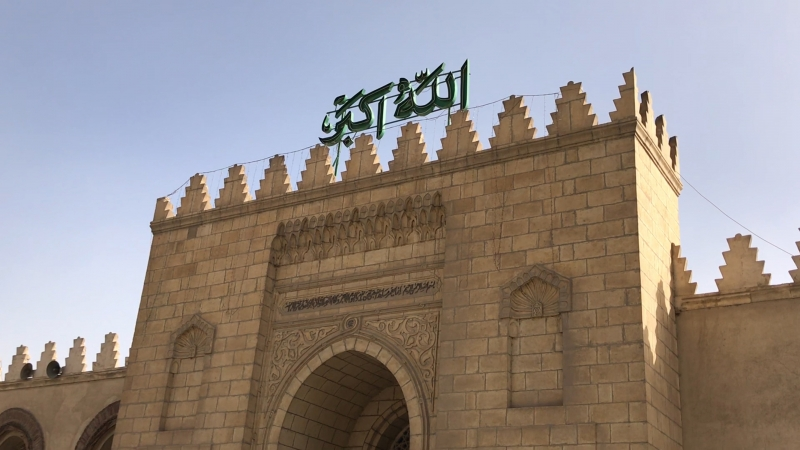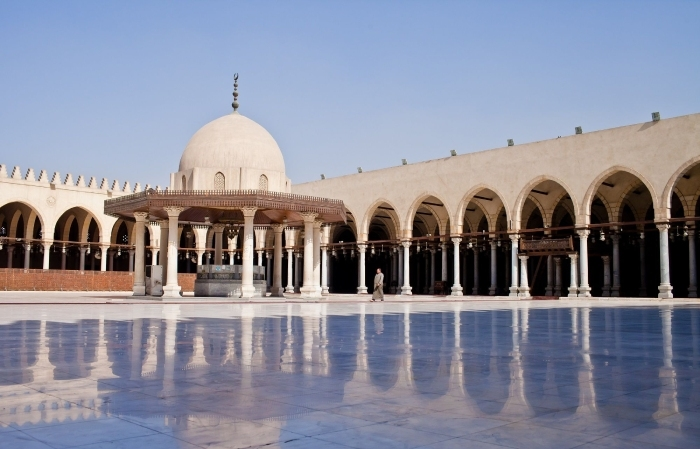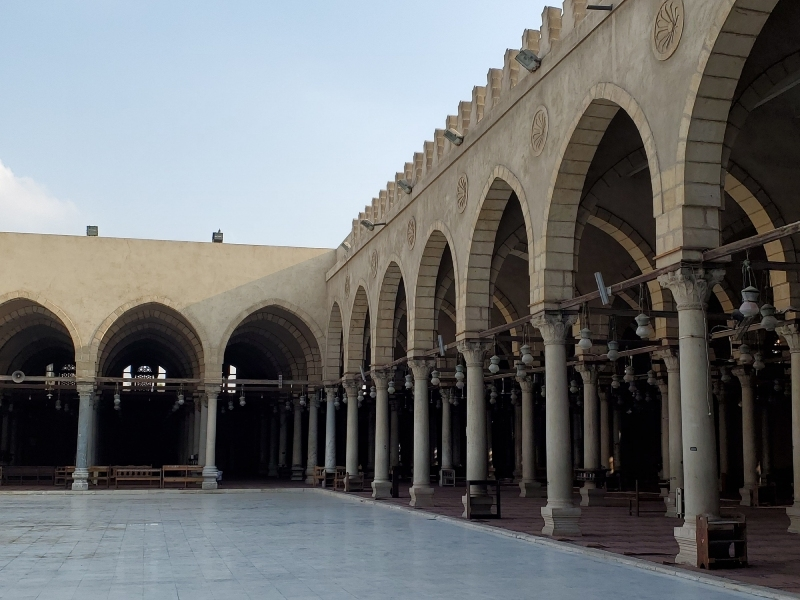Mosque of Amr ibn al-As: Egypt’s Oldest Mosque and a Living Chronicle of Faith
The Mosque of Amr Ibn Al As is the first Mosque in Egypt. The glory of this Mosque come from being the announcement of the beginning of the Islamic Period in Egypt.

Introduction: A Monument That Redefined Egypt’s Spiritual Landscape
In the heart of Old Cairo stands a monument that redefined Egypt’s spiritual and cultural identity. The Mosque of Amr ibn al-As, founded in 641 CE, is recognized as the first mosque built in Egypt and across the African continent. Its history stretches beyond religious devotion; it represents the spread of Islam, the birth of Islamic architecture in Egypt, and the formation of Fustat—the first Islamic capital.
What makes the mosque remarkable isn’t only its age but its resilience. Over fourteen centuries, it has been built, burned, expanded, and restored by successive dynasties. Each era—the Umayyads, Abbasids, Fatimids, Ayyubids, Mamluks, and Ottomans—left its architectural fingerprint, creating a layered structure that still functions as a vibrant center of prayer and community.
From a simple mud-brick and palm-frond shelter to today’s sprawling marble-pillared complex, the mosque reflects Egypt’s evolving history. Walking through its arcades means tracing centuries of learning, faith, and cultural dialogue. For those eager to explore Egypt’s Islamic heritage, the Mosque of Amr ibn al-As offers an experience where spirituality and history merge seamlessly.
Foundation of the First Mosque in Egypt
Origins in Fustat
The mosque was built by Amr ibn al-As, the commander who led the Arab conquest of Egypt. Under instructions from Caliph Umar ibn al-Khattab, it was to serve as a place of worship and community assembly. Its original structure was modest: palm trunks supported a roof of reeds and mud, while the floor was layered with gravel. There were no minarets or domes; the qibla, the direction of prayer, was marked only by simple posts.
Despite its humble beginnings, the mosque symbolized a new era for Egypt. It wasn’t just a sanctuary for prayers but a meeting point for governance and social affairs, embodying the role of the mosque as the heartbeat of early Islamic society.

Architectural Evolution Through the Ages
Umayyad Contributions
As Egypt’s Muslim population grew, the Umayyads enlarged the mosque. They introduced the first minarets, positioned at its corners, changing the city’s skyline and giving the call to prayer a prominent visual marker. This expansion solidified the mosque’s role as the focal point of Fustat.
Abbasid Enhancements
In 827 CE, under Abbasid authority, the mosque nearly doubled in size. Additional aisles and arcades were constructed, and decorative details reflected the refined style of the Abbasid period. The expansions highlighted not only functional needs but also a shift toward architectural grandeur.
Fatimid Embellishments
The Fatimids added artistic flourishes, rebuilding portions of the mosque and adorning the mihrab with silver and elaborate decoration. Their enhancements introduced beauty without compromising the mosque’s spiritual essence, elevating it into a symbol of both devotion and prestige.
Ayyubid and Mamluk Restorations
During the Ayyubid era, Saladin restored the mosque after much of Fustat was destroyed in fires meant to prevent Crusader occupation. Later, in the Mamluk period, Mourad Bey restructured large parts of the mosque, including the minarets and arcades, giving the monument much of the form seen today.
Modern Preservation
By the 19th and 20th centuries, Egypt’s rulers recognized the mosque’s cultural and historic value, initiating preservation projects. While the original structure no longer survives, the accumulated restorations tell a story of continuity and adaptation across centuries.
Layout and Key Architectural Features
Courtyard and Prayer Hall
The mosque now spans about 120 by 112 meters. Its central courtyard, open to the sky, is framed by arcades with rows of columns—many reused from Roman and Byzantine buildings. Along the qibla wall stands the hypostyle prayer hall, which houses the mihrab and a wooden minbar used for Friday sermons.
Minarets and Domes
The minarets visible today date from the 18th century. Their elegance reflects later Ottoman influences and distinguishes the mosque’s profile. Though domes were absent in its earliest form, later additions introduced them, blending function with aesthetic appeal.
Subtle Decorative Elements
While modest in comparison to later Islamic monuments, the mosque holds understated beauty. Wooden ceilings, geometric carvings, and stone inscriptions enrich its simple structure. The use of spolia—columns taken from earlier Christian buildings—offers a visual link between Egypt’s pre-Islamic and Islamic past.
Cultural and Religious Significance
A Center of Scholarship
For centuries before Al-Azhar’s founding, the Mosque of Amr ibn al-As served as Egypt’s principal center of Islamic scholarship. Renowned scholars lectured here, and students gathered to study Qur’an, Hadith, and jurisprudence. Its reputation as a seat of learning established Cairo as a beacon of intellectual and spiritual life in the Muslim world. Symbol of Enduring Faith
Despite fire, war, and repeated reconstruction, the mosque has never ceased to function as a place of prayer. Its resilience makes it a living monument, embodying the enduring role of Islam in Egypt’s cultural fabric. Five daily prayers still echo through its halls, linking modern worshippers with their 7th-century predecessors.
A Crossroads of Heritage
Located near Coptic Cairo and the Babylon Fortress, the mosque sits at a cultural crossroads. Its proximity to historic churches and the Coptic Museum highlights Cairo’s multi-layered identity, where Islamic and Christian traditions stand side by side.

The Mosque Today: Visiting Old Cairo’s Historic Gem
Visitors today find the mosque accessible, serene, and rich in atmosphere. Its arcaded courtyards and prayer halls invite reflection, while its architectural details reveal Egypt’s layered history. Early mornings and late afternoons provide the best light and quieter moments for exploration. Respectful dress is essential, as the mosque continues to function as an active house of worship.
Guides often emphasize its role as Egypt’s oldest mosque and its importance as a center of both community and scholarship. Exploring its features alongside nearby sites in Old Cairo offers a comprehensive look at the city’s enduring religious and cultural significance.
Why the Mosque of Amr ibn al-As Still Matters
The Mosque of Amr ibn al-As isn’t just an ancient monument; it’s a living space that connects past and present. As the oldest mosque in Africa, it set the foundation for Cairo’s Islamic architecture. As a center of learning, it nurtured scholars and traditions that shaped Egypt’s role in the wider Muslim world. As a resilient structure, it embodies the strength of faith across turbulent centuries.
For those tracing the roots of Islamic Egypt, walking through its halls offers a sense of continuity unmatched by other sites. Its significance lies not only in bricks and columns but in the spirit of devotion and community it continues to inspire. And for modern travelers, including those on carefully curated Egypt tours, it remains a highlight—a place where faith, history, and heritage come alive under the Cairo sun.

The mosque was founded in 641–642 CE by General Amr ibn al-As after the Arab conquest of Egypt. It marked the birth of Islamic architecture in Egypt and Africa.
Yes. It is recognized as the first mosque in Egypt and Africa, making it one of the most significant landmarks of early Islamic history.
Originally, the mosque measured about 29 by 17 meters. Through expansions by various dynasties, it now covers about 120 by 112 meters, accommodating thousands of worshippers.
The Umayyads, Abbasids, Fatimids, Ayyubids, Mamluks, Ottomans, and later Egyptian rulers all contributed to rebuilding, expanding, and restoring the mosque over the centuries.
The mosque features a large open courtyard (sahn), surrounding arcades with marble and stone columns, a prayer hall with a mihrab and minbar, and minarets added in later eras.
Before the establishment of Al-Azhar Mosque, this site was Egypt’s earliest center of Islamic scholarship, where Qur’an, Hadith, and jurisprudence were taught.
Very little. Almost none of the original 7th-century building remains; what exists has been rebuilt many times over centuries. Some architraves and architectural fragments survive along certain walls.
The mosque is open most days, generally from morning until late afternoon, though times can vary during Ramadan or holidays. Entrance is free, though donations are welcome. Visitors should dress modestly, remove shoes before entering prayer halls, and be respectful during prayer times.
Customize Your Dream Vacation!
Get in touch with our local experts for an unforgettable journey.
Plan Your Trip




























